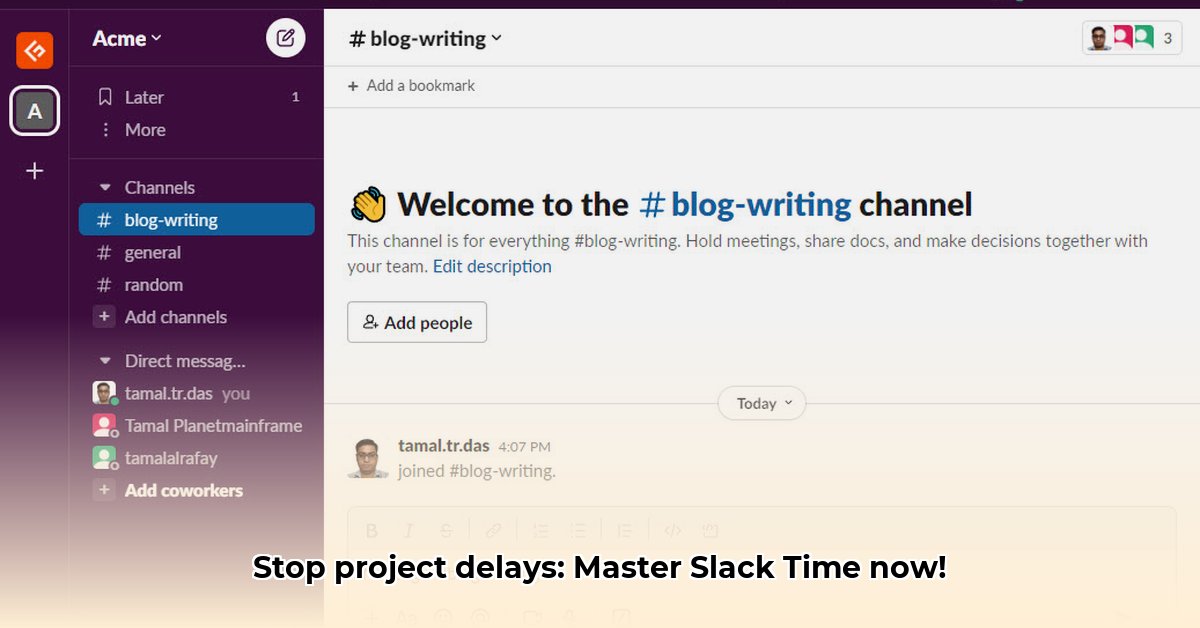Ever feel like your projects are constantly running behind schedule? The secret to smoother, less stressful projects might be something you’ve overlooked: understanding “slack time,” also called “float.” For more time management strategies, check out this helpful resource: Time Management Strategies. Think of it as built-in breathing room for your project timeline. This guide will show you how to find that breathing room, how much you need, and what to do when you run out, ensuring timely project delivery. We’ll cover different ways to manage projects and offer tips on using software to make it all easier. By the end, you’ll be a slack-time expert, keeping your projects on track and your team productive.
Deciphering Slack Time: Mastering the Art of Buffering for Project Delivery
Project success often hinges on effective time management, and a crucial element of this is understanding and utilizing “slack time.” Without it, even minor delays can quickly snowball into major problems. Let’s dive in and learn how to make this valuable tool work for you, mitigating risks and ensuring strategic resource optimization.
What is Slack Time? Identifying Project Float
Slack time, also called float, is the amount of time a task can be delayed without impacting other project tasks or the project’s overall completion date. It’s the extra time you have to complete a task without delaying the overall project schedule. No project goes exactly according to plan, so having that extra time built-in is essential. It lets you handle unexpected issues without derailing the whole project and assists greatly in effective task scheduling.
Differentiating Types of Slack Time: Free, Total, and Negative
There are three main types of slack, each telling you slightly different things about your project:
-
Total Float: This is the total amount of time a task can be delayed without pushing back the overall project finish date. It’s your overall project safety net, providing flexibility in scheduling. A lower total float suggests that you’re on a tighter schedule, leaving less room for error and requiring closer monitoring.
-
Free Float: This is how long a task can be delayed without pushing back the start date of any immediately dependent tasks. It’s a more precise measurement focusing on individual task dependencies. If mixing the cake batter has a free float of two hours, you can delay it by two hours without delaying the frosting process.
-
Negative Float: This happens when your project is already behind schedule. It indicates the amount of time required to bring the project back on track. It requires immediate action such as re-evaluation of task durations or resources.
Calculating these floats isn’t complicated, but a visual tool like a PERT chart (Program Evaluation and Review Technique) or a Gantt chart really helps. You don’t necessarily need fancy software; even a basic spreadsheet can work effectively for smaller projects.
Calculating Your Slack Time: A Comprehensive Guide
While the precise calculations can get a bit technical involving earliest and latest start/finish times, the basic idea is straightforward. Most project management software will handle these calculations automatically, but understanding the underlying principles is helpful for successful implementation.
Step 1: Define Your Tasks and Dependencies. List every task in your project and identify which tasks need to be completed before others can begin, ensuring accurate task scheduling and a logical workflow.
Step 2: Estimate Task Durations. Give each task a realistic time estimate. Be honest—it’s better to slightly overestimate than to underestimate the time required ensuring comprehensive planning and execution. Consult with team members who will be directly involved in each task to get the most accurate estimates.
Step 3: Select a Visualization Method (PERT or Gantt Chart). Choose a visual representation to show the sequence of tasks and their dependencies. Many free project management tools can help with this, enabling easy project tracking.
Step 4: Identify Earliest and Latest Start/Finish Times. For each task, determine the earliest possible start and finish time, along with the latest possible start and finish time without impacting the overall project.
Step 5: Calculate Total Float: For each task, subtract its earliest start time from its latest start time. The result is its total float, indicating overall project flexibility.
Step 6: Calculate Free Float: Determine how much a task can be delayed without affecting downstream tasks. It involves considering the dependencies and the earliest start times of subsequent tasks.
Example:
Let’s say Task A takes 3 days and must be completed before Task B (which takes 2 days) begins.
- If Task A starts on day 1, it finishes on day 3. Task B can start on day 4 and finish on day 5.
- If Task A is delayed and begins on day 2, it finishes on day 4. Task B then starts on day 5 and finishes on day 6 – pushing the whole project slightly behind.
The difference between the earliest and latest finish time of Task A represents its total and free float.
Interpreting Slack: Project Risks
Low or negative float demands immediate attention, and action is needed. Low total float means limited wiggle room; any delays will likely affect the project’s completion date. Low free float on early tasks can create a domino effect, delaying everything downstream. Analyzing this data helps pinpoint potential bottlenecks, enabling you to better allocate resources and proactively address potential problems, ensuring effective time allocation.
Integrating Slack Time in Different Project Management Methodologies
How you handle slack varies based on your project management approach:
-
Waterfall: In traditional Waterfall projects, schedules are generally more rigid, and slack time is usually explicitly planned and carefully monitored. It’s carefully calculated upfront and considered as part of the overall schedule to avoid timeline deviations.
-
Agile: Agile methodologies embrace flexibility. While there might not be the same formal calculation of slack time, the iterative nature of sprints and the ability to adjust plans based on feedback often implicitly accounts for unexpected delays, ensuring project adaptability. Sprint reviews and retrospectives provide opportunities to identify and address potential delays, keeping the project on track.
-
Critical Path Method (CPM): Slack is crucial for identifying tasks not on the critical path, providing flexibility in resource allocation.
-
Program Evaluation and Review Technique (PERT): PERT uses optimistic, pessimistic, and most likely time estimates to determine expected task durations, explicitly incorporating uncertainty and influencing slack time calculations.
Strategies for Remedying Negative Slack
Negative slack means your schedule is overly optimistic. It’s not a disaster, but it is a call to action!
Step 1: Re-evaluate Task Durations. Are task durations realistic? Have you underestimated anything?
Step 2: Identify Contributors to the Delay. What specifically is causing the negative slack?
Step 3: Adjust Project Elements. Can you shorten the duration of some tasks? Can you re-allocate resources? Might you need to ask for additional help or adjust the project’s scope? Explore options such as task splitting or parallel execution.
Step 4: Communicate with Stakeholders. Keep stakeholders aware of the situation. Transparent communication keeps everyone informed.
Leveraging Project Management Software
Good project management software automatically calculates slack time, saving you time and increasing accuracy. However, it shouldn’t replace your judgment. Software is a tool, not a magic bullet, emphasizing the need for human oversight.
Here’s a glimpse into the pros and cons of using such software:
| Feature | Pros | Cons |
|---|---|---|
| Automated Slack Calculation | Saves time, reduces errors, increases accuracy | Can be expensive, requires a learning curve, potential for over-reliance |
| Gantt Chart Visualization | Clear visual representation of project timelines and dependencies | Can become complex for very large projects with numerous tasks and dependencies |
| Risk Management Capabilities | Helps identify potential problem areas, facilitating proactive risk mitigation. | Requires accurate input and effective interpretation, emphasizing the importance of user knowledge. |
| Resource Allocation | Provides tools to effectively allocate resources based on project requirements and task dependencies. | May require integration with other systems to access real-time resource availability. |
Effective Slack Time Checklist
- Calculate total and free float for each task to identify potential schedule risks.
- Use a PERT or Gantt chart to visualize your project schedule and dependencies, enhancing project visibility.
- Pay close attention to tasks with low or negative float, addressing potential issues and proactively managing risks.
- Communicate potential issues proactively to stakeholders, ensuring everyone is informed and aligned.
- Adjust your schedule or scope as needed, optimizing resource allocation and timeline management.
- Regularly monitor and update your schedule throughout the project, adapting to changing needs and maximizing project success.
Mastering slack time isn’t about hoping for delays; it’s about strategic planning that anticipates them. By effectively managing slack, you set yourself (and your projects) up for success, mitigating risks, and ensuring a smoother project journey through adaptability.
Optimizing Slack Time: Practical Strategies for Project Delivery
Let’s face it: Missed deadlines are a project manager’s worst nightmare. But what if I told you there’s a way to prevent them? It’s called slack time – the buffer built into your schedule to absorb unexpected delays. Mastering slack time is key to project success. So, how do we do it?
Understanding Slack: Total Float vs. Free Float
First, let’s define our terms. Total float is the total leeway you have for a task before it impacts the project’s overall completion date. Free float, on the other hand, is the amount of time you can delay a task without delaying any subsequent tasks.
Calculating these is simpler than you think. Use the Critical Path Method (CPM) or Program Evaluation and Review Technique (PERT). These methods help map out dependencies between tasks, revealing which are critical and which have slack. Simple project management software can automate this calculation.
Here’s a quick visual illustrating this:
| Task | Duration | Earliest Start | Latest Start | Total Float | Free Float |
|---|---|---|---|---|---|
| A | 2 days | Day 1 | Day 1 | 0 | 0 |
| B | 3 days | Day 1 | Day 3 | 2 | 2 |
| C | 4 days | Day 3 | Day 6 | 3 | 0 |
Task A has no float; delay it and the entire project is delayed. Task B has both free float and total float. Task C has total float but no free float, as it directly impacts a subsequent task.
Optimizing Slack Time: Practical Strategies
- Accurate Estimation: This is the foundation. Involve your team in the estimation process. Use historical data, and avoid underestimation—better to have extra time. Techniques like the Delphi method can help get more accurate estimates.
- Risk Assessment: Identify potential roadblocks. What could go wrong? How likely is it? What’s the impact? This helps you decide where to add more slack. Use a risk register to document potential risks and mitigation strategies.
- Regular Monitoring: Track progress continuously. This allows for early detection of problems, providing the opportunity to adjust before it’s too late. Use earned value management (EVM) techniques to track progress against the plan.
- Communication: Keep open communication channels. Promptly addressing issues prevents small hiccups from turning into major delays, enhancing project adaptability. Implement daily stand-up meetings to foster quick communication and problem-solving.
- Resource Leveling: Smooth out resource demands to avoid bottlenecks and delays. Tools such as resource histograms can help visualize resource allocation.
- Dependency Management: Carefully analyze task dependencies to identify opportunities for parallel execution, shrinking the critical path and increasing slack.
Methodology Integration: Adapting to Different Frameworks
Different methodologies handle slack differently.
- Waterfall: Waterfall projects heavily rely on upfront planning. Slack is usually built into the schedule during the initial planning stages. Changes are more difficult and costly to implement, requiring thorough initial estimations.
- Agile: Agile methodologies, with their iterative approach, handle slack differently. Slack isn’t formally calculated as in Waterfall; however, sprint buffers or velocity adjustments inherently provide flexibility to absorb unforeseen issues. Short sprints provide constant feedback for adjustments.
- Critical Path Method (CPM): As mentioned earlier, CPM is a structured technique for identifying tasks with slack time and managing project timelines.
- Lean Project Management: Lean focuses on eliminating waste. Slack time should be viewed as a potential area for optimization.
- Scrum: Scrum uses sprint backlogs and daily stand-ups to monitor progress and adjust plans dynamically through constant feedback.
Handling Negative Slack
Negative slack means you’re behind schedule. Here’s what you do:
- Identify the Problem: Pinpoint the source of the delay.
- Evaluate Options: Can you adjust the scope? Can you reallocate resources? Can you extend the deadline?
- Communicate: Keep stakeholders informed of the situation and proposed solutions.
Project Management Software
Software tools automate slack calculations, provide visual representations (Gantt charts), and facilitate better communication. Tools like Asana, Jira, or Monday.com can greatly assist, streamlining project management tasks.
Pros: Automation, visualization, collaboration
Cons: Cost, implementation time, learning curve
Key Takeaways:
- Accurate task estimations are critical.
- Utilize CPM or PERT for precise slack calculations.
- Regular monitoring and clear communication are essential.
- Different project management methodologies require different slack management approaches.
- Proactive risk management mitigates negative slack.
- Employ project management software to streamline the process.
Slack Time Mastery: Optimizing Resource Allocation Strategies
Let’s face it: project deadlines are rarely set in stone. Unexpected delays are almost inevitable. So, how do you keep your projects on track? The answer is simple: Implement effective strategies to Master Project Slack Time by Optimizing Resource Allocation. It’s about building in buffer time, that essential cushion against the inevitable bumps in the road.
Understanding Slack Time
Slack time, also known as float, is the amount of wiggle room built into your project schedule. It’s the difference between the earliest your task can start and the latest it can finish without delaying the entire project. Think of it as your project’s safety net. Without it, even minor setbacks can trigger a domino effect, leading to missed deadlines and frustrated teams.
There are two main types of slack:
- Total Float: This is the total amount of time a task can be delayed without impacting the project’s overall completion date.
- Free Float: This is the amount of time a task can be delayed without delaying the next task in the sequence. It’s a more granular view of slack, focusing on individual task dependencies.
Calculating Slack Time Data
Calculating slack isn’t rocket science. You’ll need to know your earliest start time (EST), latest start time (LST), earliest finish time (EFT), and latest finish time (LFT) for each task. These are typically determined using techniques like the Critical Path Method (CPM).
- Identify Task Dependencies: Clearly define what tasks must be completed before others can begin, ensuring seamless workflow.
- Calculate EST & EFT: Determine the earliest possible start and finish times for each task, maximizing efficiency.
- Calculate LST & LFT: Working backward from your project deadline, find the latest times each task can start and finish without delaying the project, maintaining project timelines.
- Calculate Total Float: Subtract EST from LST (or EFT from LFT). This gives you the total flexibility for that task.
- Calculate Free Float: This is slightly more complex and depends on the task’s dependencies. Consult a project management handbook or software for detailed guidance. Project management software can calculate free float automatically.
Analyzing Slack for Risk and Bottlenecks
Once you’ve calculated your slack, it’s time to analyze your results. Tasks with zero or negative slack are on your critical path – delaying these directly impacts your project deadline. Tasks with significant slack represent opportunities for flexibility. You can re-allocate resources from these tasks to areas needing more attention.
Managing and Addressing Negative Slack
Negative slack is a red flag. It means your schedule is unrealistic, and delays are already built-in. Don’t panic; instead, act decisively:
- Re-evaluate Estimates: Were your initial task duration estimates overly optimistic? Use techniques such as three-point estimating (optimistic, pessimistic, and most likely) to improve accuracy.
- Prioritize Tasks: Focus resources on critical path tasks, ensuring timely completion. Apply the Pareto principle (80/20 rule) to identify the tasks that have the greatest impact.
- Request Additional Resources: Consider extra support or extending deadlines, enhancing resource availability. Evaluate the cost-benefit of adding resources.
- Reprioritise: Are there tasks that can be temporarily deferred or reduced in scope to free up resources?
- Fast Tracking: Analyze the possibility of performing tasks concurrently that were initially planned sequentially.
Integrating Slack into Different Methodologies
How you manage slack differs slightly across methodologies:
- Waterfall: More emphasis on upfront planning; slack is built in during the initial project phase, ensuring comprehensive planning.
- Agile: Slack is built into sprint cycles, allowing teams to adapt to changing priorities, resulting in more responsive handling. Time-boxing and daily stand-ups facilitate regular monitoring.
- Critical Path Method (CPM): As discussed, CPM is a technique for identifying and managing the sequence of critical tasks to optimize project timelines.
- Lean Project Management: Focus on eliminating waste and maximizing efficiency.
Project Management Software
Project management software significantly simplifies the processes for managing slack time. It automates calculations, provides visual representations of your schedule, and facilitates collaborative management of slack time.
Pros: Automated calculations, enhanced visualization, and improved team collaboration, optimizing project tracking.
Cons: Requires learning curve, potential software costs and dependency, and risk of incorrect data entry/interpretation, necessitating proper user training.
Key Takeaways:
- Incorporate Slack: Always account for buffer time in your project schedule. It is your project’s safety net.
- Understand Total vs. Free Float: knowing the difference enables more precise resource allocation, maximizing efficiency.
- Regularly Monitor: Continuously review slack levels to identify and manage risks.
- Utilize Software: Employ project management software to streamline calculations and enhance team collaboration.
- Proactive Approach: Address negative slack immediately to mitigate potential delays, ensuring timely project delivery.
Project Slack Time Management: Agile Risk Mitigation
Key Takeaways:
- Accurate slack time calculation is crucial for successful project delivery.
- Understanding and using total and free float is key to effective risk mitigation.
- Agile methodologies require dynamic slack adjustment; Waterfall needs a more upfront approach.
- Negative slack demands immediate action to prevent project delays.
- Project management software streamlines calculations and monitoring.
Project Slack: What It Is, and Why It’s Key
Project slack—also known as buffer time—is the cushion built into your schedule. It’s that extra time you add to account for the unexpected. Think of it as insurance against Murphy’s Law: if something can go wrong, it probably will. Without adequate slack, even minor hiccups can snowball into significant delays, impacting deadlines and budgets. Effective Project Slack Time Management: Mitigating Risks in Agile Methodologies is essential for ensuring project success.
Project Slack: Calculation
First, let’s define two key types of slack:
- Total Float: The total amount of time a task can be delayed without delaying the project’s end date, providing overall flexibility.
- Free Float: The amount of time a task can be delayed without delaying the start of any subsequent tasks, enabling smooth transitions.
Here’s how to calculate them manually, although project management software automates the process:
- Determine Task Durations: Estimate the time needed for each task, enhancing timeline accuracy. Consult historical data.
- Identify Dependencies: Establish the sequence of tasks. Which tasks must finish before others can begin? Create a dependency matrix.
- Calculate Earliest Start and Finish Times: Work forward through your schedule, optimizing efficiency.
- Calculate Latest Start and Finish Times: Work backward from the project’s deadline, ensuring timely completion.
- Calculate Total Float: For each task, subtract the earliest finish time from the latest finish time. Formula: Total Float = Latest Finish – Earliest Finish.
- Calculate Free Float: For each task, subtract the earliest finish time from the earliest start time of the next dependent task.
A simple example:
| Task | Duration (days) | Earliest Start | Earliest Finish | Latest Start | Latest Finish | Total Float | Free Float |
|---|---|---|---|---|---|---|---|
| Task A | 3 | 0 | 3 | 0 | 3 | 0 | 0 |
| Task B | 2 | 3 | 5 | 1 | 3 | -2 | N/A |
| Task C | 4 | 5 | 9 | 3 | 7 | 2 | 2 |
| Task D | 2 | 9 | 11 | 7 | 9 | 2 | 0 |
Notice Task B has negative total float—a red flag! Task D has total float but no free float because it is the last task of the sequence. If we had a Task E starting after task D, then Task D would have free float as well. N/A refers to Task B cannot start unless Task A is complete.
Analysis and Interpretation
The table above gives you insights. Zero total float indicates a critical path task—any delay here impacts the project. Negative float means you’re behind schedule. Positive float offers flexibility. Use this information to:
- Prioritize: Focus on critical path tasks, ensuring timely completion.
- Allocate Resources: Shift resources to address tasks with negative or low float, optimizing resource allocation.
- Re-plan: Adjust schedules, durations, or dependencies as needed, enhancing project adaptability.
- Identify potential bottlenecks: Focus on tasks where dependencies may cause delays.
Methodologies and Slack
Project Slack Time Management: Mitigating Risks in Agile Methodologies is different than Waterfall.
- Agile: Regular sprints allow for continuous adaptation. Slack is adjusted iteratively, enhancing overall project flexibility. Sprint reviews and retrospectives offer opportunities to adjust.
- Waterfall: Slack needs to be carefully planned upfront, as changes are more costly, necessitating thorough initial estimations.
Addressing Negative Slack
Negative slack signals trouble. Your planned schedule is unrealistic. Act quickly:
- Re-evaluate estimates: Are task durations accurate? Conduct a root cause analysis.
- Negotiate deadlines: Is the overall project timeline achievable? Communicate with stakeholders.
- Cut scope: Can non-essential tasks be removed or postponed? De-scoping may be necessary.
- Add resources: Adding personnel can help accelerate critical path tasks, enhancing project execution.
Tools and Software
Tools like Asana, Jira, and MS Project automate slack calculations and help track progress. This improves accuracy and reduces manual effort. However, ensure the software fits your project’s needs and team’s workflow. Consider user-friendliness and integration capabilities.
- How To Balance Coaching And Personal Life For Well-Being - January 6, 2026
- Work Life Balance Coach Transforms Stress into Sustainable Well-being - January 5, 2026
- Work-Life Balance Solutions: Strategies for Achieving Personal and Professional - January 4, 2026
















